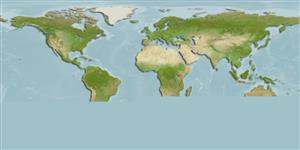Holocephali (chimaeras) >
Chimaeriformes (Chimaeras) >
Chimaeridae (Shortnose chimaeras or ratfishes)
Etymology: Chimaera: Named for the mythological creature composed of parts of multiple animals, referring to their odd mix of characteristics (See ETYFish); fulva: From fulvus (L.), brown (actually tawny or reddish brown), referring to brownish body coloration (See ETYFish).
More on authors: Didier, Last & White.
Environment: milieu / climate zone / depth range / distribution range
Ecology
Marine; bathydemersal; depth range 780 - 1095 m (Ref. 76965). Temperate
Southern Australia.
Size / Weight / Age
Maturity: Lm ? range ? - ? cm
Max length : 100.0 cm TL male/unsexed; (Ref. 76965); 118.7 cm TL (female)
Short description
Identification keys | Morphology | Morphometrics
This species is distinguished from its congeners by the following set of characters: thin, deciduous skin; color silvery pink to pale brownish; preopercular and oral lateral line canals sharing a common branch; short dorsal spine, subequal or slightly shorter than first dorsal fin; claspers of adult males long (17-19% BDL), trifurcate, divided for slightly less than half of their length; structure of the CO1 gene (Ref. 76965).
Life cycle and mating behavior
Maturity | Reproduction | Spawning | Eggs | Fecundity | Larvae
Didier, D.A., P.R. Last and W.T. White, 2008. Three new species of the genus Chimaera Linnaeus (Chimaeriformes: Chimaeridae) from Australia. In Last, P.R., White, W.T. & Pogonoski, J.J. (eds.): Descriptions of New Australian Chondrichthyans. CSIRO Marine and Atmospheric Research Paper no. 22. (Ref. 76965)
IUCN Red List Status (Ref. 130435: Version 2024-1)
Threat to humans
Harmless
Human uses
Tools
Special reports
Download XML
Internet sources
Estimates based on models
Preferred temperature (Ref.
123201): 2.2 - 7, mean 5.4 °C (based on 76 cells).
Phylogenetic diversity index (Ref.
82804): PD
50 = 0.5000 [Uniqueness, from 0.5 = low to 2.0 = high].
Bayesian length-weight: a=0.00331 (0.00137 - 0.00798), b=3.07 (2.86 - 3.28), in cm total length, based on LWR estimates for this (Sub)family-body shape (Ref.
93245).
Trophic level (Ref.
69278): 3.7 ±0.6 se; based on size and trophs of closest relatives
Resilience (Ref.
120179): Very Low, minimum population doubling time more than 14 years (Preliminary K or Fecundity.).
Fishing Vulnerability (Ref.
59153): High to very high vulnerability (71 of 100).
